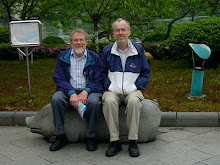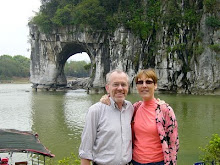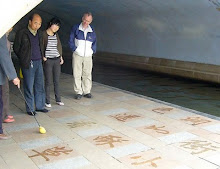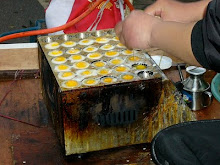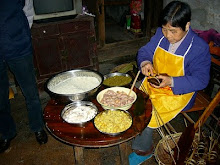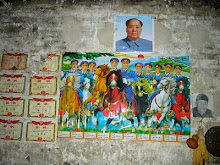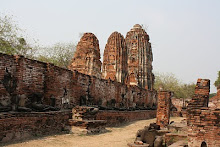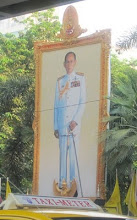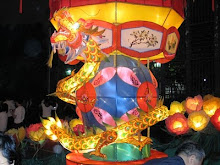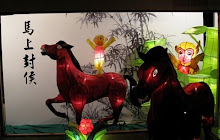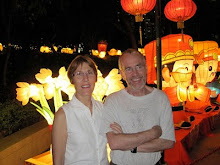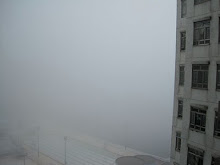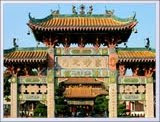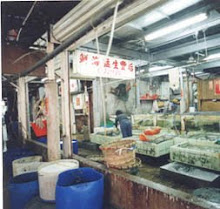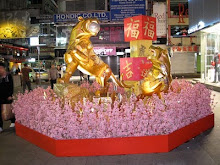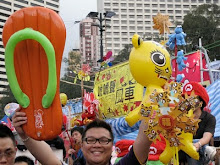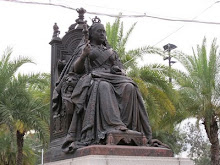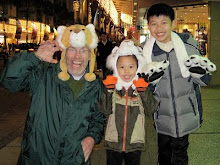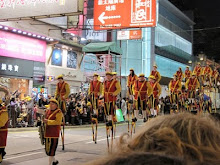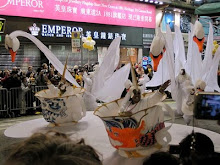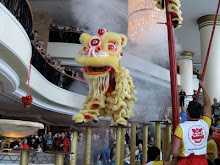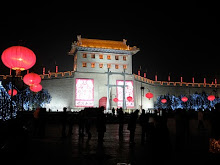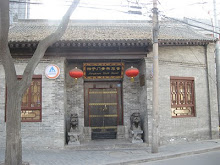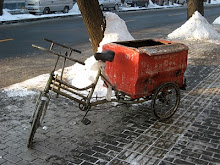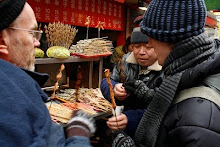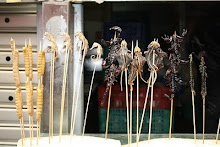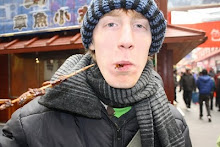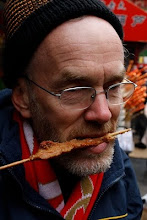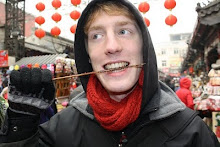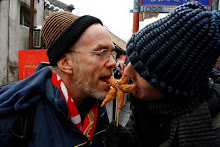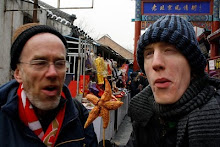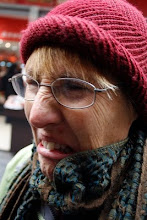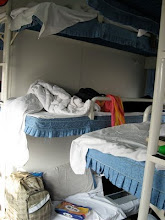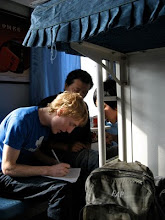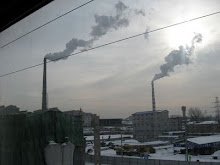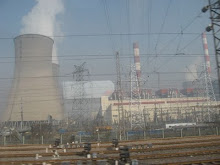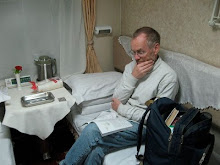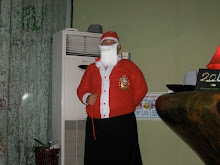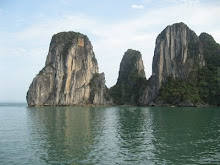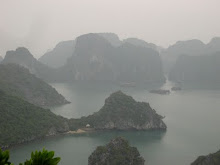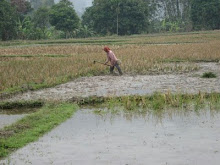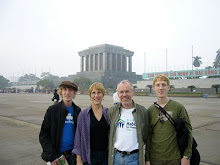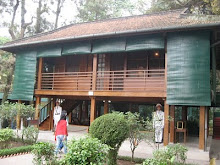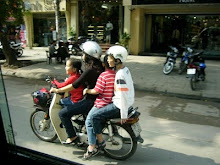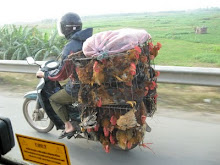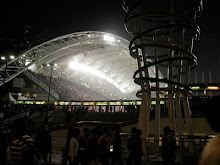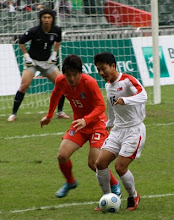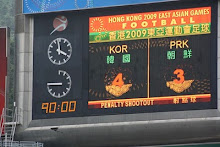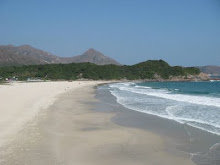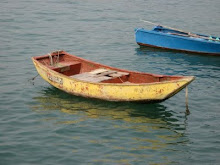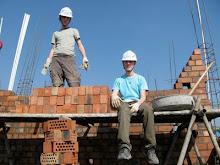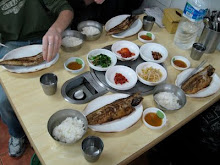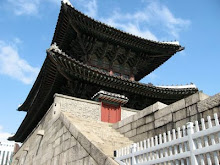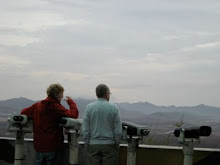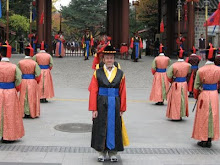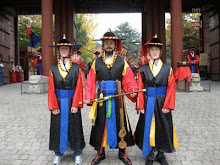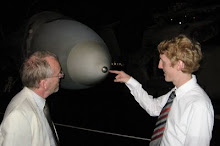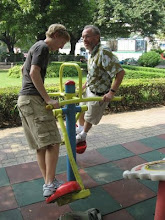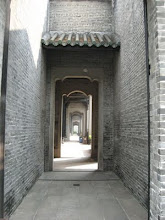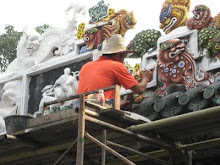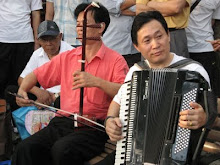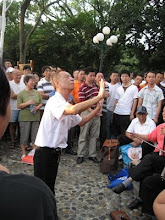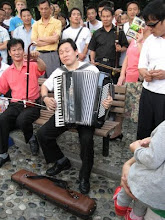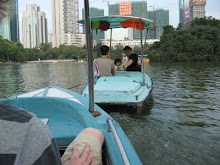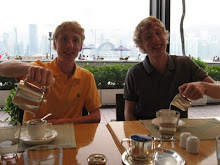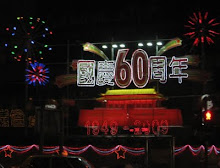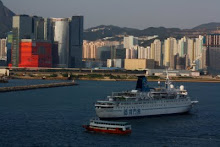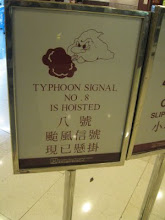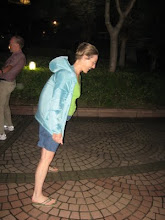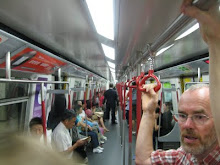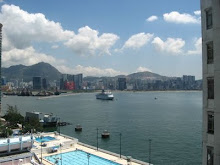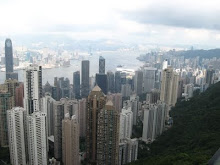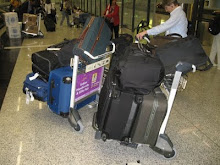This weekend we took advantage of a 3 day weekend to spend 2 of them in Guangzhou. It is a 2 hour train ride from here, an interesting joint venture between the capitalist MTR of Hong Kong and the Chinese rail system.. They cooperate very well together to give a highly efficient and pleasant service, from which Amtrak could learn a lot. My only quibble was that the restaurant car doubled as the smoking car, but given the shortness of the ride, I could live with that, particularly since part of the service was to deliver a bottle of water to each of us.
Guangzhou is better known in the west as Canton and so, unlike Shenzhen (last week’s Chinese sortie) is very old. It is old with respect to Chinese culture (as in 1000s of years) and also in terms of interactions with the west as a center for trade. A few weeks back we went to an art exhibit at the Hong Kong Museum of Art that was laid out as a travel guide to Canton, not to be used after 1850. Lots of paintings and drawings showing what the average Victorian tourist might see and do there. I believe that Guangzhou is now the third largest city in China and so it has lasted well and prospered.
English is understood and spoken only to a very limited extent. But a little pantomime goes a long way and we did not really have any problems. The hotel had little cards on which we would get them to write the names of places we wanted to go for taxi drivers. Plus we had a pretty good map that we could use to negotiate destinations. We also used the subway, though for the 4 of us, taxis came out to be the same price with greater flexibility.
Lack of being able to speak Cantonese or Mandarin to any significant extent led to interesting food experiences. Lunch 1 right after we arrived had to be close to the hotel since we were hungry. We went of the Hunan based on the fact that it was on the 6th floor and any restaurant that survives there has got to be good. The menu had very good pictures. We did not appreciate that Hunan = spicy and so unlike last week when we negotiated around one very spicy dish in Shenzhen, here they were all like that. But that tasted very good, particularly the fried eggplant and the river shrimp. Dinner ended up being Middle Eastern, for reasons also related to language, but that I won’t go into. One of the managers befriended us. He was from Jordan and insisted on going around the very extensive buffet and explaining each dish to us. Everything was very good, but also quite expensive by local standards and so we felt obliged to overeat. The next day we were in a market at lunchtime, so we just randomly selected a busy market café. There did not seem to be any menus, but the food on other people’s plates looked good and then it turned out that one of these people spoke some English. We ended up getting 4 plates of what she had (fried noodles – they were excellent, especially with a little chili sauce and fresh cilantro added) and 4 oranges sodas (because they were cold and presumably microbiologically sound). The whole meal cost 28 yuan for the 4 of us – which amounts to about US$4.50. You could spend the same amount, well actually more, on a tall latte at one of the several Starbucks, also to be found in Guangzhou. I guess we are one of the few bizarre people who frequent both kinds of establishment.
But the high point of Guangzhou for me was the Chen Ancestral home. A beautiful, very well preserved collection of buildings, about 150 years old. The decorative carvings were magnificent, either in stone, brick, wood or plaster. The whole thing was very nicely laid out and also housed a folk art museum. The museum had just about the most spectacular embroideries I have ever seen, very realistic landscapes, but with the sheen of the thread giving a texture you would not see in other mediums. There were also wonderful multiple-layered ivory carvings – I have no idea how they are done. We also had chops made. This was my solution to the problem of not being able to write my Chinese name. A chop is a stamp, in this case made out of soft stone, so now my Chinese illiteracy can be concealed. The chop carving was followed by an extended bout of tea tasting. All in all, a wonderful place to visit.
Tuesday, October 27, 2009
Tuesday, October 20, 2009
This past weekend we celebrated getting our visas for Mainland China by taking a day trip to Shenzhen. I have heard that it is the fasted growing city in the world. It currently has a population of 14 million and when there I learned that its population in 1979 was less then 20,000. So that record would take some beating. The growth was due to Premier Deng Xioaping, Mao's successor, who declared Shenzhen to be a Special Economic Zone. I am not sure what that meant, but it certainly worked in terms of stimulating growth.
It is right across the border from Hong Kong. In fact we got there by taking the MTR (metro) to the end of the line and then walking across into China. We were accompanied by 1000's of other people - it is also apparently one of the most traveled crossing points in the world. Of course, it is not really a border, because both sides are in the same country, but we certainly went through two sets of immigration controls. It took time but it was straightforward.
Many people (both local and expatriates) warned us to beware of pickpockets in Shenzhen. Many people go up there to shop because prices are cheaper than Hong Kong. There is a giant mall just across the border and countless men soliciting the wealthy looking visitors to come and buy whatever. I am not a shopper at the best of times (except for food) and we just kept walking until we had passed through that area.
Our first stop was a store selling CDs and DVDs. The DVDs included those released last week and they all cost 20 yuan, which is about $3. Duncan decided he had to try one out. The quality was pretty mediocre for both sound and video, but the packaging was very impressive. We next went into a mall because it seemed to be advertizing tea. Unlike Hong Kong, few signs are in English. It contained the largest collection of stores selling tea and tea ware that I have ever seen. Outside, each store somebody would be sitting picking over the teas, separating the leaves from the twigs. They would invite us in to drink some tea, in the hope that we would buy. Other stores sold teapots and others still tea trays. This is different from a British tea tray, in that Chinese tea ceremonies involve lots of spillage and so your tray needs to be able to collect all that liquid. The ones that I had seen before were all made of wood or bamboo, but here there were beautiful ones made from stone, with extensive carving. They weighed a ton, but we are plotting how one might find its way back to Connecticut. For the time being we resisted all purchases and moved on.
Our target was the tallest building in Shenzhen because we heard that you could get to its top. We found it and discovered that the top was advertized as the first theme park in Asia at the top of a skyscraper. We paid our money and went up to discover spectacular views and a tacky theme park, which I suppose is what I expected. From the top, we could see a park nearby with a lake and boats for rent. We decided first lunch and then a boat ride.
Lunch was a little hard to find, which it never is in Hong Kong. But eventually we found a likely looking spot, went in and pointed to what we wanted on the menu (which fortunately had good pictures). There was one person there who spoke a little English and she warned us that the fish soup we ordered was hot. When it came, we discovered she had spoken the truth. An interesting in-your-face heat, very raw and irritating to the throat. But very flavorful too. The rest of the food was more moderate (and therefore typically Cantonese). The other interesting things about that restaurant were the large jars of picked snakes. I tried to find out more about them but the English speaker had by that time left.
So off to the park, where the first exciting thing was the grass. There is so little of it in our part of Hong Kong. We rented our boat, which had a small electric motor and seemed to go slower than all of the others. After a little while, our motor gave up entirely. Fortunately, our plight was apparent without language and another boat towed us back to the dock.
But while we were out on the lake, we heard music, so when back on dry land we went to investigate. Tucked away in the woods, we came across several groups of people who had just come together to play music. The first group we listened to had an accordion player and then two people playing the erhu, a simple two stringed instrument played with a bow. They were wonderful and pretty soon were joined by people who knew the words to the songs they were playing. They joined in as equal partners, not just singing along quietly in the background, but really giving it their all. Then another man came along who decided to be the conductor. The whole group of them was so passionate and completely involved in their music it was spellbinding. There was another group playing Chinese jazz (four saxes, guitar, flute and some kind of horn) and then just a solo sax player with vocalist. Then there were the feather hacky sacs, the badminton games, the dancers and martial artists etc. etc. I loved it all. If only that went on in our local parks in the USA ...
It is right across the border from Hong Kong. In fact we got there by taking the MTR (metro) to the end of the line and then walking across into China. We were accompanied by 1000's of other people - it is also apparently one of the most traveled crossing points in the world. Of course, it is not really a border, because both sides are in the same country, but we certainly went through two sets of immigration controls. It took time but it was straightforward.
Many people (both local and expatriates) warned us to beware of pickpockets in Shenzhen. Many people go up there to shop because prices are cheaper than Hong Kong. There is a giant mall just across the border and countless men soliciting the wealthy looking visitors to come and buy whatever. I am not a shopper at the best of times (except for food) and we just kept walking until we had passed through that area.
Our first stop was a store selling CDs and DVDs. The DVDs included those released last week and they all cost 20 yuan, which is about $3. Duncan decided he had to try one out. The quality was pretty mediocre for both sound and video, but the packaging was very impressive. We next went into a mall because it seemed to be advertizing tea. Unlike Hong Kong, few signs are in English. It contained the largest collection of stores selling tea and tea ware that I have ever seen. Outside, each store somebody would be sitting picking over the teas, separating the leaves from the twigs. They would invite us in to drink some tea, in the hope that we would buy. Other stores sold teapots and others still tea trays. This is different from a British tea tray, in that Chinese tea ceremonies involve lots of spillage and so your tray needs to be able to collect all that liquid. The ones that I had seen before were all made of wood or bamboo, but here there were beautiful ones made from stone, with extensive carving. They weighed a ton, but we are plotting how one might find its way back to Connecticut. For the time being we resisted all purchases and moved on.
Our target was the tallest building in Shenzhen because we heard that you could get to its top. We found it and discovered that the top was advertized as the first theme park in Asia at the top of a skyscraper. We paid our money and went up to discover spectacular views and a tacky theme park, which I suppose is what I expected. From the top, we could see a park nearby with a lake and boats for rent. We decided first lunch and then a boat ride.
Lunch was a little hard to find, which it never is in Hong Kong. But eventually we found a likely looking spot, went in and pointed to what we wanted on the menu (which fortunately had good pictures). There was one person there who spoke a little English and she warned us that the fish soup we ordered was hot. When it came, we discovered she had spoken the truth. An interesting in-your-face heat, very raw and irritating to the throat. But very flavorful too. The rest of the food was more moderate (and therefore typically Cantonese). The other interesting things about that restaurant were the large jars of picked snakes. I tried to find out more about them but the English speaker had by that time left.
So off to the park, where the first exciting thing was the grass. There is so little of it in our part of Hong Kong. We rented our boat, which had a small electric motor and seemed to go slower than all of the others. After a little while, our motor gave up entirely. Fortunately, our plight was apparent without language and another boat towed us back to the dock.
But while we were out on the lake, we heard music, so when back on dry land we went to investigate. Tucked away in the woods, we came across several groups of people who had just come together to play music. The first group we listened to had an accordion player and then two people playing the erhu, a simple two stringed instrument played with a bow. They were wonderful and pretty soon were joined by people who knew the words to the songs they were playing. They joined in as equal partners, not just singing along quietly in the background, but really giving it their all. Then another man came along who decided to be the conductor. The whole group of them was so passionate and completely involved in their music it was spellbinding. There was another group playing Chinese jazz (four saxes, guitar, flute and some kind of horn) and then just a solo sax player with vocalist. Then there were the feather hacky sacs, the badminton games, the dancers and martial artists etc. etc. I loved it all. If only that went on in our local parks in the USA ...
Monday, October 12, 2009
We have now been in Hong Kong for almost 2 months and I have yet to write anything about why I came here in the first place. Actually, I am still trying to figure that out, but my understanding of it does deepen as the weeks go by.
In a nutshell, Hong Kong has decided to transform its education system by lopping a year off high school and adding a year onto university, changing the latter from three to four years. Another way to look at it would be to say they are switching from a British to a US program. I had assumed that switch reflected the world's realpolitik. It seems that the US has as much influence in Hong Kong now as the UK. And then of course, the major influence on Hong Kong, i.e. the country of which it is a part, China, sends its students to college for four years.
It turns out that the decision was a little more rationally based. Hong Kong students have always scored very well on tests of quantitative ability; in fact they put the US to shame. In addition, in the international survey of universities published by the Times Higher Education Supplement last week, Hong Kong placed 5 in the top 200, led by Hong Kong University at #24. Even my institution, Hong Kong Polytechnic University, squeaked in at #195. UConn did not make the list. These league tables are always a little peculiar, with a large component based on subjective assessments, I think in this case of college presidents. However despite this rosy picture, when local employers were surveyed, they said that they would much rather hire graduates of US or European universities than those from Hong Kong institutions. Although Hong Kong graduates knew a lot, their ability to think critically and creatively and adapt to changing situations was limited. Since the opinions of local employers are very important in this capital of commerce, these surveys were taken very seriously, hence the wholesale changes that are now being undertaken.
Universities here are increasing their curriculum by one third. They have also been encouraged to do so not simply by adding a year at the beginning, but rather to rethink the entire undergraduate programs. Of course, the extent to which they are truly doing this is questionable, but that is the idea. It is an enormous, courageous and exciting undertaking. It would never happen in the US, where the system is too big and too decentralized. But here there are 8 publicly funded universities and so such changes can be mandated.
After the changes were announced, a Hong Kong businessman by the name of Po Chung got involved. He had attended college in the US and developed a very high regard for the idea and practice of a liberal education. He saw the reforms as a wonderful opportunity to get Hong Kong students to think more broadly and creatively. Together with the Hong Kong America Center, which administers the Fulbright programs here, he came up with the idea of bringing 20 US scholars who had worked extensively with GenEd programs to Hong Kong over a period of 4 years to help with the changes and try to ensure the programs developed were as strong as possible. He gave US$1M, matched here in Hong Kong to make it happen.
So here I am, slowly figuring out the workings of PolyU and the other institutions of higher education and determining what makes sense. More on
In a nutshell, Hong Kong has decided to transform its education system by lopping a year off high school and adding a year onto university, changing the latter from three to four years. Another way to look at it would be to say they are switching from a British to a US program. I had assumed that switch reflected the world's realpolitik. It seems that the US has as much influence in Hong Kong now as the UK. And then of course, the major influence on Hong Kong, i.e. the country of which it is a part, China, sends its students to college for four years.
It turns out that the decision was a little more rationally based. Hong Kong students have always scored very well on tests of quantitative ability; in fact they put the US to shame. In addition, in the international survey of universities published by the Times Higher Education Supplement last week, Hong Kong placed 5 in the top 200, led by Hong Kong University at #24. Even my institution, Hong Kong Polytechnic University, squeaked in at #195. UConn did not make the list. These league tables are always a little peculiar, with a large component based on subjective assessments, I think in this case of college presidents. However despite this rosy picture, when local employers were surveyed, they said that they would much rather hire graduates of US or European universities than those from Hong Kong institutions. Although Hong Kong graduates knew a lot, their ability to think critically and creatively and adapt to changing situations was limited. Since the opinions of local employers are very important in this capital of commerce, these surveys were taken very seriously, hence the wholesale changes that are now being undertaken.
Universities here are increasing their curriculum by one third. They have also been encouraged to do so not simply by adding a year at the beginning, but rather to rethink the entire undergraduate programs. Of course, the extent to which they are truly doing this is questionable, but that is the idea. It is an enormous, courageous and exciting undertaking. It would never happen in the US, where the system is too big and too decentralized. But here there are 8 publicly funded universities and so such changes can be mandated.
After the changes were announced, a Hong Kong businessman by the name of Po Chung got involved. He had attended college in the US and developed a very high regard for the idea and practice of a liberal education. He saw the reforms as a wonderful opportunity to get Hong Kong students to think more broadly and creatively. Together with the Hong Kong America Center, which administers the Fulbright programs here, he came up with the idea of bringing 20 US scholars who had worked extensively with GenEd programs to Hong Kong over a period of 4 years to help with the changes and try to ensure the programs developed were as strong as possible. He gave US$1M, matched here in Hong Kong to make it happen.
So here I am, slowly figuring out the workings of PolyU and the other institutions of higher education and determining what makes sense. More on
Monday, October 5, 2009
This week has seen an interesting juxtaposition of two events, the 60th anniversary of the founding of the People's Republic of China and the Mid-Autumn Festival. Both were pretty big events, though not necessarily to the same people, and I enjoyed being a casual observer of both.
The build up to the 60th anniversary has been quite pervasive and long lasting. We have been aware of it since we arrived here, with lots of posters, neon displays, artistic performances etc., etc. It all came to a head on the day itself, Thursday October 1st. That day marked the beginning of an unprecedented 8 day holiday on the Mainland (though not in Hong Kong), which conveniently included the Mid-Autumn Festival. Thursday was a public holiday in Hong Kong. I don't know how people treat public holidays here, but as far as I could tell for the most part it seemed like a good reason for not going to work. I decided to take my parade watching semi-seriously, although since it was in Beijing that meant sitting in front of the TV. As anybody who watched the last Olympics knows, the Chinese know how to run a parade. This one was divided into two parts, the military and the cultural. I found both surprisingly interesting. The soldiers, for example, were selected for being in the parade on the basis of height. They were all the same, being between 1.8 and 1.9 m, I think. That makes it look very good, because you see an array of soldiers, aligned in perfect rows and columns, all the same height. It is a 3-dimensional masterpiece! We were wondering if some of them were wearing lifts in their shoes to make up for small differences in height. And then they drill those soldiers to such an extent that all movement is perfectly synchronized. Actually, that part goes for the cultural portion of the parade as well - they must spend a phenomenal amount of time practicing. I did not pay too much attention to the military hardware although there was a lot of it.
The cultural part of the parade was much more colorful. As a backdrop, Tienemann Square was filled with people who were holding up, probably colored cloth, so that all you see is a sea of color. But the sea has Chinese characters in it that are spelling out something. Then, almost instantaneously, the colors of the background and the characters change to spell out something new. My conclusion was that each unit of space was occupied by two people, one standing and visible and the other crouching and hidden. At set times they would swap positions, to make the color changes. In front of this backdrop they had a very impressive parade. We are already planning for the boombox parade in Willimantic next year. Do you know that China has only had 4 presidents in the past 60 years. They tend to be long-lasting. Each was represented by a large painting drawn on a float surrounded by colorful dancers.
I could go on, but I won't except to say that the commentary was very interesting. The Hong Kong TV station took the direct feed from China, complete with audio. It was totally gushing, I guess like the Macy's Thanksgiving Day parade, except that it does come across a little differently when it is tanks rather than an inflatable Snoopy going past. But then the Beijing commentary was regularly interspersed with that from the Hong Kong station, which, while not being overtly critical, was certainly questioning. This Hong Kong attitude towards the mainland is well illustrated by the coverage in the South China Morning Post. They devoted a lot of space to the anniversary, with diverse perspectives represented. There was a table of 60th anniversary events in Hong Kong that included all the official stuff, but then just as many, if not more, protest activities focused on human rights - marches, candle-lit vigils and so on. Another time I will have to write about Hong Kong attitudes towards mainland China/ the UK/ the USA and so on. These things are complex here.
The Mid Autumn Festival seems to me a lot more straightforward, although it is very old and has some connection with liberation from the Mongols. But everybody decorates with paper lanterns and gives their neighbors mooncakes. These are baked confections that come in many flavors; disc shaped and filled with locust bean paste and egg yolks. I would not rate them at the top of my list of desirable pastries, but people here are very attached to them. Then at night, the big thing is to go out and greet the harvest moon. The children take their lanterns with candles when they do so and get up to interesting tricks with the hot wax. I did not get to see that myself, because we had spent the day hiking on Lamma Island and were pretty exhausted by the heat. More of that another time.
The build up to the 60th anniversary has been quite pervasive and long lasting. We have been aware of it since we arrived here, with lots of posters, neon displays, artistic performances etc., etc. It all came to a head on the day itself, Thursday October 1st. That day marked the beginning of an unprecedented 8 day holiday on the Mainland (though not in Hong Kong), which conveniently included the Mid-Autumn Festival. Thursday was a public holiday in Hong Kong. I don't know how people treat public holidays here, but as far as I could tell for the most part it seemed like a good reason for not going to work. I decided to take my parade watching semi-seriously, although since it was in Beijing that meant sitting in front of the TV. As anybody who watched the last Olympics knows, the Chinese know how to run a parade. This one was divided into two parts, the military and the cultural. I found both surprisingly interesting. The soldiers, for example, were selected for being in the parade on the basis of height. They were all the same, being between 1.8 and 1.9 m, I think. That makes it look very good, because you see an array of soldiers, aligned in perfect rows and columns, all the same height. It is a 3-dimensional masterpiece! We were wondering if some of them were wearing lifts in their shoes to make up for small differences in height. And then they drill those soldiers to such an extent that all movement is perfectly synchronized. Actually, that part goes for the cultural portion of the parade as well - they must spend a phenomenal amount of time practicing. I did not pay too much attention to the military hardware although there was a lot of it.
The cultural part of the parade was much more colorful. As a backdrop, Tienemann Square was filled with people who were holding up, probably colored cloth, so that all you see is a sea of color. But the sea has Chinese characters in it that are spelling out something. Then, almost instantaneously, the colors of the background and the characters change to spell out something new. My conclusion was that each unit of space was occupied by two people, one standing and visible and the other crouching and hidden. At set times they would swap positions, to make the color changes. In front of this backdrop they had a very impressive parade. We are already planning for the boombox parade in Willimantic next year. Do you know that China has only had 4 presidents in the past 60 years. They tend to be long-lasting. Each was represented by a large painting drawn on a float surrounded by colorful dancers.
I could go on, but I won't except to say that the commentary was very interesting. The Hong Kong TV station took the direct feed from China, complete with audio. It was totally gushing, I guess like the Macy's Thanksgiving Day parade, except that it does come across a little differently when it is tanks rather than an inflatable Snoopy going past. But then the Beijing commentary was regularly interspersed with that from the Hong Kong station, which, while not being overtly critical, was certainly questioning. This Hong Kong attitude towards the mainland is well illustrated by the coverage in the South China Morning Post. They devoted a lot of space to the anniversary, with diverse perspectives represented. There was a table of 60th anniversary events in Hong Kong that included all the official stuff, but then just as many, if not more, protest activities focused on human rights - marches, candle-lit vigils and so on. Another time I will have to write about Hong Kong attitudes towards mainland China/ the UK/ the USA and so on. These things are complex here.
The Mid Autumn Festival seems to me a lot more straightforward, although it is very old and has some connection with liberation from the Mongols. But everybody decorates with paper lanterns and gives their neighbors mooncakes. These are baked confections that come in many flavors; disc shaped and filled with locust bean paste and egg yolks. I would not rate them at the top of my list of desirable pastries, but people here are very attached to them. Then at night, the big thing is to go out and greet the harvest moon. The children take their lanterns with candles when they do so and get up to interesting tricks with the hot wax. I did not get to see that myself, because we had spent the day hiking on Lamma Island and were pretty exhausted by the heat. More of that another time.
Subscribe to:
Posts (Atom)

